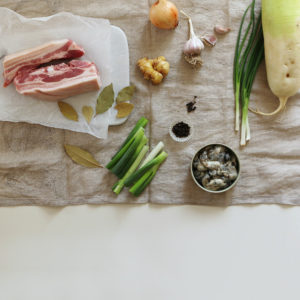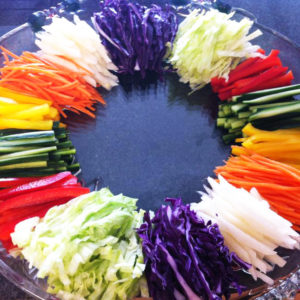Napa cabbage wraps with boiled pork and spice mixture. Serve with rice and side dishes (Serving 2 adult).
serving size: 2
- one 12 ounce piece of fresh pork belly (un-smoked bacon) with skin

- 5 cloves garlic, pealed
- 3 inch fresh ginger root, peeled
- 2 table spoon Korean soy bean paste (doenjang)
- 1 table spoon instant coffee
- 1 onion, peeled
- 10 cup water
preparation:
Put water, garlic, ginger, soybean paste, instant coffee and onion in a deep pot and boil over high heat. Wash the pork in running water and put it in the pot when it starts to boil. Close the lid and briefly bring back to a boil. Turn the heat down to medium-high and continue to cook for 50-60 minutes or until fully cooked (pork the meat with metal chopstick and when it is fully cooked, no blood will come out). Use tongs to pick out the pork and place it on the cutting board. Slice the pork into thin slices and transfer to a serving plate.
soybean paste dipping sauce:
- 1 table spoon Korean soybean paste (doenjang)
- 1 tablespoon minced garlic
- 1 tablespoon grated onion
- 1 tablespoon Asian sesame oil
- 1 tablespoon sesame seeds, toasted
Put all the ingredients in a bowl and stir to mix well.
Spicy Korean Radish
- 1/2 pound Korean radishes, 2-inch-long fine julienne strips
- 1/2 teaspoon salt
- 2 teaspoons red pepper powder
- 1/2 teaspoon minced garlic
- pinch of grated fresh garlic
- 1/4 teaspoon granulated sugar
Put radish in a bowl and sprinkle the salt on top. Briefly mix and let sit for about 30 minutes. Gently squeeze the water out. Add red pepper powder, garlic, ginger, and sugar and mix in together.

